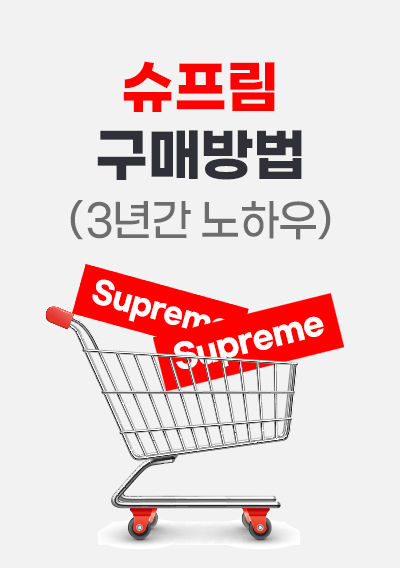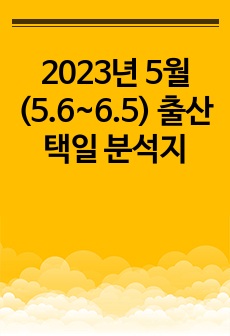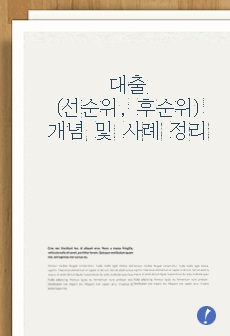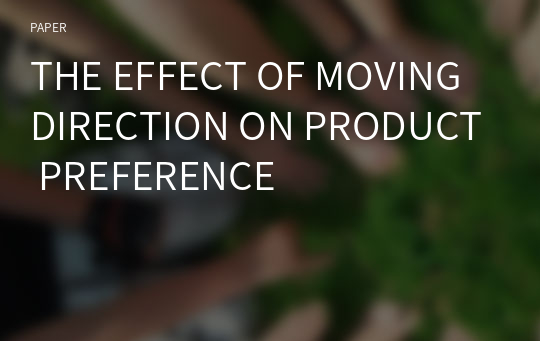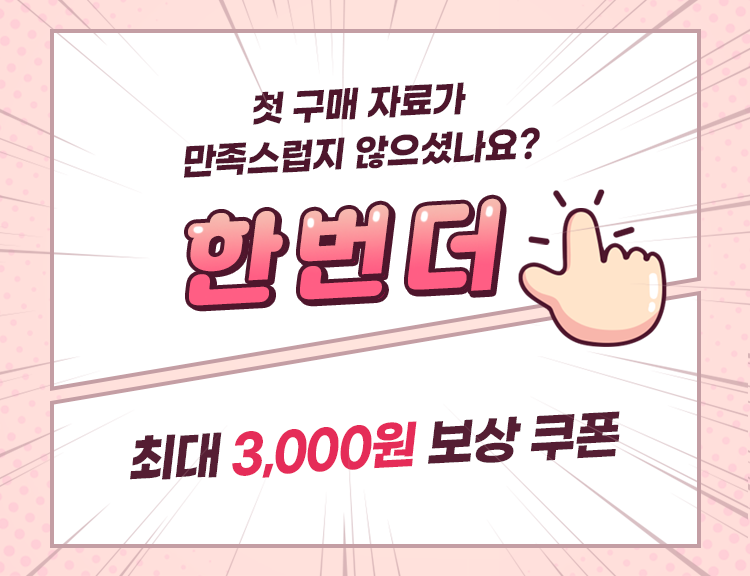THE EFFECT OF MOVING DIRECTION ON PRODUCT PREFERENCE
* 본 문서는 배포용으로 복사 및 편집이 불가합니다.
서지정보
ㆍ발행기관 : 글로벌지식마케팅경영학회(GFMC)
ㆍ수록지정보 : Global Marketing Conference
ㆍ저자명 : I-Shan Hsieh, Ryoka Asakura, Yuri Komon, Shota Narukawa, Ryoichiro Mitsuda, Mayuko Nishii, Takeshi Moriguchi
ㆍ저자명 : I-Shan Hsieh, Ryoka Asakura, Yuri Komon, Shota Narukawa, Ryoichiro Mitsuda, Mayuko Nishii, Takeshi Moriguchi
영어 초록
Introduction The concept of “processing fluency” has been widely discussed in various areas, including marketing and consumer behavior (Janiszewski and Meyvis, 2001; Labroo et al., 2008; Herrmann et al., 2013; Shen and Rao, 2016). Processing fluency is defined as the ease with which people process information, and it has been found that experiencing fluency while processing information has a positive effect on decision making. Many researchers have shown that fluency elicits positive evaluation. For example, the mere-exposure effect has been explained by processing fluency; repeated exposure to a stimulus increases processing fluency and the fluency, in turn, increases positive affect (Arkes, 2013; Janiszewski and Meyvis, 2001). Many factors have been examined in fluency studies. Among them, the most common method to affect fluency is font manipulation (e.g., Alter et al., 2007; Alter and Oppenheimer, 2008). In these studies, researchers examined processing fluency of objects with clear fonts or unclear fonts and found the former enhanced processing fluency and thus caused positive evaluation for the objects. There are many other factors related to visual perceptual fluency, such as contrast of letters and background, exposure time, and so on. Processing fluency can be influenced by eye movement. For example, Shen and Rao (2016) focused on the relation between fluency of eye movements and product evaluation. They found that repetition of an eye movement could enhance perceived fluency and that this perceived fluency could increase product evaluation. In their second experiment, they manipulated participants’ eye movement by moving a ball on the computer screen and found that the consistency between the direction of eye movement and the direction of products (pen and sports shoe) could enhance processing fluency and product evaluation. Similar to the study of Shen and Rao, we focus on the relation between the direction of products and processing fluency. Shen and Rao focused on eye movement, whereas our study concentrated on human body movement—namely, walking and riding. There are many advertisements in stores, trains, buses and on the roads. Consumers often see these advertisements while walking or riding. In these cases, they move to certain directions, and sometimes products in advertisements convey direction (e.g., automobiles, shoes, pens, and so on). At the time of exposure, consistency between two directions (consumer’s movement and product) may influence processing fluency and product evaluation. In a walking condition, the direction of physical body movement of the participants can be related to their eye movements. However, in a riding condition, the moving direction of a vehicle the participant rides does not always coincide with the direction of participant’s eye movement. We can therefore assume that if consistency of the two directions affects the product evaluation positively not only in a walking condition but in a riding condition, it is possible to verify the existence of the effects of human body movement. Based on the above considerations, we conducted two experiments.Empirical Studies
In two experiments, all participants were undergraduate students at a major university in Tokyo. They were recruited at a university campus or via social network services. The experiments were conducted in two conditions: participants looking at the advertisement while walking or riding on the bus. In prior research focused on eye movement (Shen and Rao, 2016), the researchers examined the relation between eye movement and product location (left side or right side on the advertisements) as well as product direction (directed toward the left or toward the right). They showed that the participants preferred the product directed toward the right (pen or sports shoe) or located on the right side (cupcake) when their eyes moved from left to right. Conversely, the participants liked the product directed toward the left or located on the left better when their eyes moved from right to left. Based on their study, we also chose two types of products, sports shoe and bottled water. Sports shoe has a horizontal direction, so we can place the product in the advertisement with a particular direction (toward the left or toward the right). On the other hand, bottled water does not have horizontal direction, thus we use the product with a particular location (placed on the left side or right side in the advertisements). We hypothesize that the participants will experience processing fluency and express a greater preference towards the products in the advertisement when its direction or location matches the moving direction of the participants.
Experiment 1
One-hundred-and-twenty students participated in a 2 × 2 between-subjects factorial design. Participants were randomly assigned into four groups: 2 moving direction × 2 product layouts. The experiment was set up in a classroom where the advertisements were displayed on the walls. On the wall to the left side of the classroom, the advertisement for sports shoe was displayed with the direction either toward the left or the right. On the wall to the right, the advertisement for bottled water was displayed with the product location either on the left or right side. On the front wall of the classroom, an advertisement for hamburger which had neither particular direction nor location was displayed as a dummy stimulus. The participants were asked to walk around the classroom either clockwise or counter-clockwise. They walked by the wall without stopping while looking at an advertisement and then rated preference and processing fluency regarding the product shown in the advertisement immediately afterwards one by one. For the participants who walked around the classroom clockwise, the products directed toward the right (or located on the right side) might appear more natural and thus enhance their processing fluency. On the other hand, the participants who walked counter-clockwise felt fluency regarding the products directed toward the left (or located on the left side). The results supported our hypotheses. There were significant differences between matched groups and unmatched groups in both preference and processing fluency. Participants who walked around the classroom clockwise showed a higher preference and fluency regarding sports shoe directed toward the right and bottled water located on the right side in the advertisements. Similarly, participants who walked around the classroom counter-clockwise presented a higher preference and fluency regarding sports shoe directed toward the left and bottled water located on the left side.
Experiment 2
In experiment 2, we used school buses running between campuses as the vehicle in which the participants looked at the advertisements. We set up two situations of placing the advertisements for considering the effect of the moving scenery outside the bus window on the perception of the participants. We placed one near the ceiling, where participants can barely see the scenery outside the window, and the other on the window, where the participants can easily see scenery moving right behind the advertisement. The participants either stood or sat on the buses and then rated preference and processing fluency regarding the products on the advertisements right after getting off the bus. One-hundred-and-two students participated in a 2 × 2 between-subjects factorial design. The participants were randomly assigned into matched-above, unmatched-above, matched-window, and unmatched-window groups. The matched condition meant that the moving direction and product layouts were consistent. When the moving direction of the bus and the product layout (direction of sports shoe and location of bottled water) were consistent, we defined matched condition. Otherwise, we defined unmatched condition. The results supported our hypotheses. For the advertisements placed near the ceiling, there were significant differences between matched and unmatched groups in both preference and processing fluency for both sports shoe and bottled water. On the other hand, for the advertisements placed on the window, there were no significant differences between matched and unmatched groups. When the advertisements were placed on the window, the direction of the moving scenery outside the bus window was opposite to the direction of the bus. This might have cancelled out the effects of moving direction.
Discussion and Conclusion
The empirical studies showed that for the condition of participants walking, the orientation and the location of the product pointing in the same direction as the moving direction of the participants resulted in higher processing fluency, and led to higher product preference. Meanwhile, for the condition of participants moving towards a certain direction by passive means, such as taking a bus, product preference and processing fluency increase when the advertisement is placed up near to the ceiling, and the orientation or the location of the product match the moving direction of the participants. At the same time, there is no significant difference in product preference or processing fluency when the advertisement is placed on the window. In closing, our research has provided an initial look at how consistency between two directions (consumer’s movement and product) can have significant effects on consumers’ processing fluency and product evaluation. Consumers often look at the advertisements while walking or riding and advertisers can know the main direction of consumers’ movement. In these cases, they can determine the direction or the location of the products in the advertisements considering the consistency with the moving direction of consumers. Recently, digital signage in trains and buses has become popular and advertisers can easily adjust the direction or the location of the products in the advertisements on it. Therefore, the knowledge extracted from our research may be readily available for advertisers.
참고 자료
없음"Global Marketing Conference"의 다른 논문
 THE ROLES OF GREEN PACKAGING IN UGLY FOOD PURCHASE INTE..22페이지
THE ROLES OF GREEN PACKAGING IN UGLY FOOD PURCHASE INTE..22페이지 THE IMPACT OF INDUCED AWE ON ETHICAL TOURIST BEHAVIORS5페이지
THE IMPACT OF INDUCED AWE ON ETHICAL TOURIST BEHAVIORS5페이지 A BIBLIOMETRIC ANALYSIS OF SPIRITUAL TOURISM RESEARCH15페이지
A BIBLIOMETRIC ANALYSIS OF SPIRITUAL TOURISM RESEARCH15페이지 SOCIAL NETWORK ANALYSIS AND RESPONSE TIME TESTING: CONS..11페이지
SOCIAL NETWORK ANALYSIS AND RESPONSE TIME TESTING: CONS..11페이지 THE EFFECTS OF PARA-SOCIAL INTERACTION ON ONLINE CELEBR..3페이지
THE EFFECTS OF PARA-SOCIAL INTERACTION ON ONLINE CELEBR..3페이지 THE INFLUENCE OF OPINION LEADERS ON DAILY DEALS USER’S ..3페이지
THE INFLUENCE OF OPINION LEADERS ON DAILY DEALS USER’S ..3페이지 HOW IMMERSIVE RETAILING AFFECTS CONSUMERS’ URGE TO BUY:..6페이지
HOW IMMERSIVE RETAILING AFFECTS CONSUMERS’ URGE TO BUY:..6페이지 KEY TO SUPERSTARDOM IN A GLOBALISED MARKET: THE ROLE OF..6페이지
KEY TO SUPERSTARDOM IN A GLOBALISED MARKET: THE ROLE OF..6페이지 A POST-PANDEMIC LOOK AT TOURISTS’ PERCEIVED COOLNESS OF..4페이지
A POST-PANDEMIC LOOK AT TOURISTS’ PERCEIVED COOLNESS OF..4페이지 EXTRACTING OFFLINE RETAIL SHOPPING PATTERNS: OLLABORATI..5페이지
EXTRACTING OFFLINE RETAIL SHOPPING PATTERNS: OLLABORATI..5페이지











